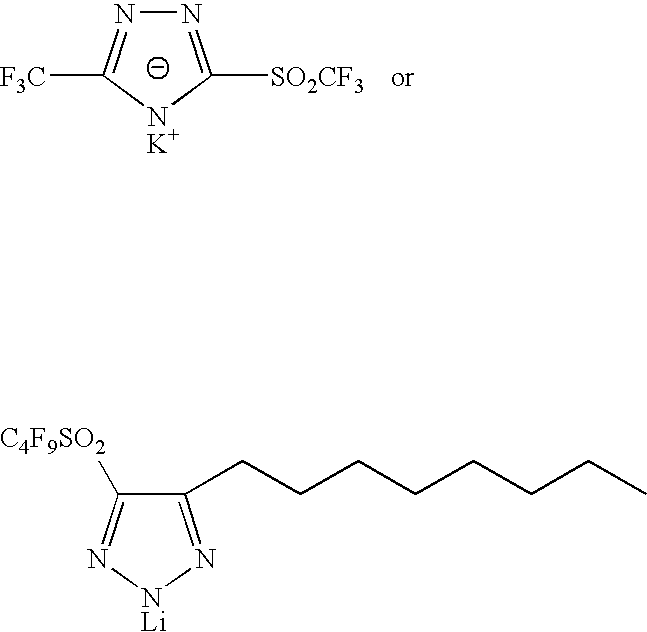Sulphonyl-1,2,4-triazole salts
a technology of sulphonyl-1,2,4triazole and sulphonyl1, which is applied in the field of sulphonyl1, 2, 4triazole salts, can solve the problems of inability to find an alternative solvent, failure to achieve the effect of finding an alternative solvent, and relatively complex synthesis,
- Summary
- Abstract
- Description
- Claims
- Application Information
AI Technical Summary
Benefits of technology
Problems solved by technology
Method used
Image
Examples
example 2
Preparation of HBCST
[0186]50 g of 3,5-dimercapto-1,2,4-triazole was synthesized starting from 2,5-dithiobiurea brought to reflux for 24 hours in water in the presence of two equivalents of NaOH (according to the process described in GB-1049053). The solution is subsequently acidified with HCl, the precipitate is filtered off and redissolved in water in the presence of NaHCO3, and the solution is filtered and then acidified with HCl under an inert atmosphere. A precipitate of 3,5-dimercapto-1,2,4-triazole was thus recovered.
[0187]The protocol of example 1 was subsequently reproduced, replacing the 3-tri-fluoromethyl-5-mercapto-1,2,4-triazole with 3,5-dimercapto-1,2,4-triazole, and 3,5-dichlorosulfonyl-1,2,4-triazole was obtained.
example 3
Preparation of Cl—SO2-TrH—(CF2)z-TrH—SO2Cl Compounds
[0188]Preparation of the dithiol HS-TrH—(CF_)z-TrH—SH, z=2, 3, 4)
[0189]22.69 g (100 mmol) of tetrafluorosuccinyl chloride Cl(O═)CCF2CF2C(═O)Cl (supplied by SynQuest Labs.) were added slowly to a suspension of 18.23 g (200 mmol) of thiosemicarbazide (supplied by Aldrich) in 100 ml of dioxane containing 15.82 g (200 mmol) of pyridine. After stirring for 24 hours, the solvent was evaporated off and the product obtained was washed with water and then brought to reflux in 150 ml of a 10% aqueous solution of NaOH. After cooling, the reaction medium was acidified with HCl, and the product was recovered by settling out and then purified twice by sublimation under vacuum. The following compound was thus obtained:
[0190]The protocol above was reproduced, replacing the tetrafluorosuccinyl chloride with 100 mmol of hexafluoroglutaryl chloride Cl(O═)CCF2CF2CF2C(═O)Cl and with 100 mol of octafluoroadipoyl chloride (both provided by SynQuest Labs....
example 4
Preparation of RF-TrH-SO2Cl Compounds
Preparation of RFTrH—SH Thiols
[0192]23.25 g (100 mmol) of heptafluorobutyryl chloride CF3(CF2)2C(═O)Cl (supplied by SynQuest Labs.) were added slowly to a suspension of 9.11 g (100 mmol) of thiosemicarbazide (supplied by Aldrich) in 100 ml of dioxane containing 7.91 g (100 mmol) of pyridine. After stirring for 24 hours, the solvent was evaporated off, and the product obtained was washed with water and then brought to reflux in 150 ml of a 10% aqueous solution of NaOH. After cooling, the reaction medium was acidified with HCl, and the product was recovered by settling out and then purified by sublimation under vacuum. The following compound was thus obtained:
[0193]The protocol above was reproduced, successively replacing the heptafluoro-butyryl chloride with 100 mmol of nonafluoropentanoyl chloride, 100 mmol of tetrafluoropropionyl chloride, 100 mmol of 2,2-difluoroacetyl chloride and 100 mol of pentafluoropropionyl chloride, all the chlorides ori...
PUM
| Property | Measurement | Unit |
|---|---|---|
| Length | aaaaa | aaaaa |
| Temperature | aaaaa | aaaaa |
| Temperature | aaaaa | aaaaa |
Abstract
Description
Claims
Application Information
 Login to View More
Login to View More - R&D
- Intellectual Property
- Life Sciences
- Materials
- Tech Scout
- Unparalleled Data Quality
- Higher Quality Content
- 60% Fewer Hallucinations
Browse by: Latest US Patents, China's latest patents, Technical Efficacy Thesaurus, Application Domain, Technology Topic, Popular Technical Reports.
© 2025 PatSnap. All rights reserved.Legal|Privacy policy|Modern Slavery Act Transparency Statement|Sitemap|About US| Contact US: help@patsnap.com



